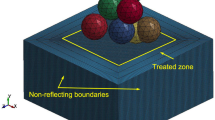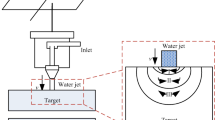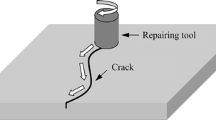Abstract
Abrasive waterjet peening is a preferable alternative to traditional shot peening which can be used for surface strengthening of structural components. The fatigue crack behavior of 2024 aluminum alloy specimen treated by abrasive waterjet peening was investigated in this paper. The jet flow field was analyzed firstly by adopting CFD. The peening process was then modeled to calculate the residual stress distribution on the target surface, and the results were verified by experiments. The numerical model for the fatigue test was then established for evaluating the crack growth characteristics in the specimen with residual compression induced by the peening. The results indicated that the effective stress intensity factor range and the crack propagation rate are reduced due to the peening-induced residual stress. The effective stress intensity factor range reaches 13.1 MPa·m0.5, and the crack propagation rate reaches 1.7 × 10–7 mm/cycle at the depth of maximum residual stress, respectively. The crack closure coefficient decreases with an increase of the shot peening intensity, while increases with an increase of the stress ratio.















Similar content being viewed by others
Data availability
This is not applicable.
Code availability
The software used in the present study is authorized.
References
Soyama H (2019) Comparison between the improvements made to the fatigue strength of stainless steel by cavitation peening, water jet peening, shot peening and laser peening. J Mater Process Technol 269:65–78. https://doi.org/10.1016/j.jmatprotec.2019.01.030
Kim JC, Cheong SK, Noguchi H (2013) Evolution of residual stress redistribution associated with localized surface microcracking in shot-peened medium-carbon steel during fatigue test. Int J Fatigue 55:147–157. https://doi.org/10.1016/j.ijfatigue.2013.06.010
Seddik R, Bahloul A, Atig A, Fathallah R (2017) A simple methodology to optimize shot-peening process parameters using finite element simulations. Int J Adv Manuf Technol 90:2345–2361. https://doi.org/10.1007/s00170-016-9532-1
Srivastava M, Hloch S, Krejci L, Chattopadhyaya S, Gubeljak N, Milkovic M (2022) Utilizing the water hammer effect to enhance the mechanical properties of AISI 304 welded joints. Int J Adv Manuf Technol 119:2317–2328. https://doi.org/10.1007/s00170-021-08357-9
Li H, Wang J, Kwok N, Nguyen T, Yeoh GH (2018) A study of the micro-hole geometry evolution on glass by abrasive air-jet micromachining. J Manuf Process 31:156–161. https://doi.org/10.1016/j.jmapro.2017.11.013
Srivastava M, Hloch S, Krejci L, Chattopadhyaya S, Dixit AR, Foldyna J (2018) Residual stress and surface properties of stainless steel welded joints induced by ultrasonic pulsed water jet peening. Measurement 127:453–462. https://doi.org/10.1016/j.measurement.2018.06.012
Srivastava M, Hloch S, Tripathi R, Kozak D, Chattopadhyaya S, Dixit AR, Foldyna J, Hvizdos P, Fides M, Adamcik P (2018) Ultrasonically generated pulsed water jet peening of austenitic stainless-steel surfaces. J Manuf Process 32:455–468. https://doi.org/10.1016/j.jmapro.2018.03.016
Arola D, McCain ML (2000) Abrasive waterjet peening: a new method of surface preparation for metal orthopedic implants. J Biomed Mater Res 53:536–546. https://doi.org/10.1002/1097-4636(200009)53:5%3c536::AID-JBM13%3e3.0.CO;2-V
Arola D, McCain ML, Kunaporn S, Ramulu M (2001) Waterjet and abrasive waterjet surface treatment of titanium: a comparison of surface texture and residual stress. Wear 249:943–950. https://doi.org/10.1016/S0043-1648(01)00826-2
Sadasivam B, Hizal A, Arola D (2009) Abrasive waterjet peening with elastic prestress: a parametric evaluation. Int J Mach Tools Manuf 49:134–141. https://doi.org/10.1016/j.ijmachtools.2008.10.001
Zou X, Liang Y, Wu Z, Yang M, Hu J (2017) Study on surface properties and thermal relaxation behavior of residual stress field of carburizing GDL-1 Steel after Abrasive Water Jet Peening. J Mech Eng 53:43–49. https://doi.org/10.3901/JME.2017.22.043
Wang Z, Ma Z, Chen T, Fan C, Yu T, Zhao J (2023) Experimental investigation into the effect of process parameters on the Inconel 718 surface integrity for abrasive waterjet peening. Surf Coatings Technol 454:129186. https://doi.org/10.1016/j.surfcoat.2022.129186
Fernández Pariente I, Guagliano M (2008) About the role of residual stresses and surface work hardening on fatigue ΔKth of a nitrided and shot peened low-alloy steel. Surf Coatings Technol 202:3072–3080. https://doi.org/10.1016/j.surfcoat.2007.11.015
Torres MAS, Voorwald HJC (2002) An evaluation of shot peening, residual stress and stress relaxation on the fatigue life of AISI 4340 steel. Int J Fatigue 24:877–886. https://doi.org/10.1016/S0142-1123(01)00205-5
Franchim AS, de Campos VS, Travessa DN, de Neto C, M, (2009) Analytical modelling for residual stresses produced by shot peening. Mater Des 30:1556–1560. https://doi.org/10.1016/j.matdes.2008.07.040
Kim T, Lee H, Hyun HC, Jung S (2011) A simple but effective FE model with plastic shot for evaluation of peening residual stress and its experimental validation. Mater Sci Eng A 528:5945–5954. https://doi.org/10.1016/j.msea.2011.04.012
Bag A, Lévesque M, Brochu M (2020) Effect of shot peening on short crack propagation in 300 M steel. Int J Fatigue 131:105346. https://doi.org/10.1016/j.ijfatigue.2019.105346
Wang Y, Zhang Y, Song G, Niu W, Xu Z, Huang C (2020) Effect of shot peening on fatigue crack propagation of Ti6Al4V. Mater Today Commun 25:101430. https://doi.org/10.1016/j.mtcomm.2020.101430
Qin Z, Li B, Zhang H, Youani Andre Wilfried T, Gao T, Xue H (2022) Effects of shot peening with different coverage on surface integrity and fatigue crack growth properties of 7B50-T7751 aluminum alloy. Eng Fail Anal 133:106010. https://doi.org/10.1016/j.engfailanal.2021.106010
Turnbull A, De Los Rios ER, Tait RB, Laurant C, Boabaid JS (1998) Improving the fatigue crack resistance of 2024–t351 aluminum alloy by shot peening. Fatigue Fract Eng Mater Struct 21:1513–1524. https://doi.org/10.1046/j.1460-2695.1998.00125.x
Li D, Kang Y, Wang X, Ding X, Fang Z (2016) Effects of nozzle inner surface roughness on the cavitation erosion characteristics of high speed submerged jets. Exp Therm Fluid Sci 74:444–452. https://doi.org/10.1016/j.expthermflusci.2016.01.009
Cao ZC, Cheung CF (2014) Theoretical modelling and analysis of the material removal characteristics in fluid jet polishing. Int J Mech Sci 89:158–166. https://doi.org/10.1016/j.ijmecsci.2014.09.008
De Los Rios ER, Trull M, Levers A (2000) Modelling fatigue crack growth in shot-peened components of Al 2024–T351. Fatigue Fract Eng Mater Struct 23:709–716. https://doi.org/10.1046/j.1460-2695.2000.00287.x
Funding
This work is supported by the Shandong Provincial Key Laboratory of Precision Manufacturing and Non-traditional Machining and Natural Science Foundation of Shandong Province (ZR2020ME154).
Author information
Authors and Affiliations
Contributions
Zhe Lv completed the main work of writing, simulation, and experimental works, Rongguo Hou conducted parts of the modeling and analyzing. Huanyong Cui helped in conceiving the research schemes. Miaomiao Zhang organized the data of simulations and experiments. Hao Yun conducted parts of the experimental works.
Corresponding authors
Ethics declarations
Conflicts of interest
The authors declare no competing interests.
Additional information
Publisher's note
Springer Nature remains neutral with regard to jurisdictional claims in published maps and institutional affiliations.
Rights and permissions
Springer Nature or its licensor (e.g. a society or other partner) holds exclusive rights to this article under a publishing agreement with the author(s) or other rightsholder(s); author self-archiving of the accepted manuscript version of this article is solely governed by the terms of such publishing agreement and applicable law.
About this article
Cite this article
Lv, Z., Hou, R., Cui, H. et al. Numerical study on fatigue crack behavior of 2024 Al alloy in abrasive waterjet peening. Int J Adv Manuf Technol 127, 2979–2988 (2023). https://doi.org/10.1007/s00170-023-11742-1
Received:
Accepted:
Published:
Issue Date:
DOI: https://doi.org/10.1007/s00170-023-11742-1




